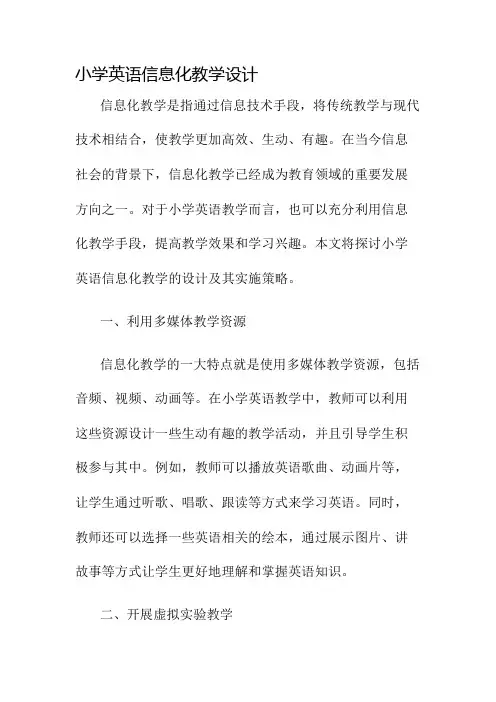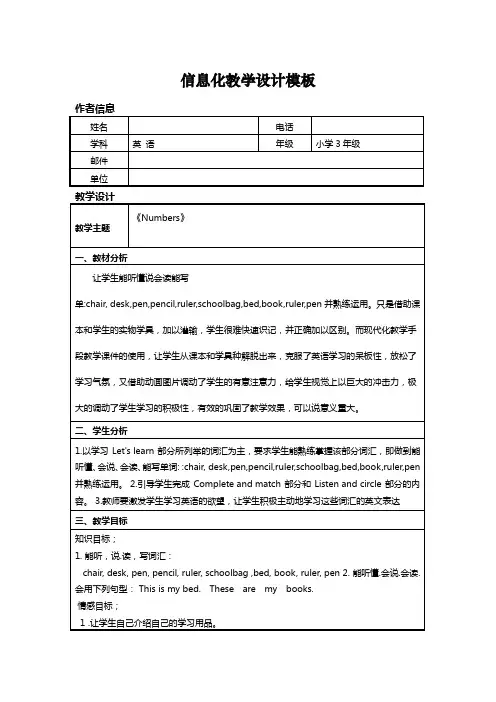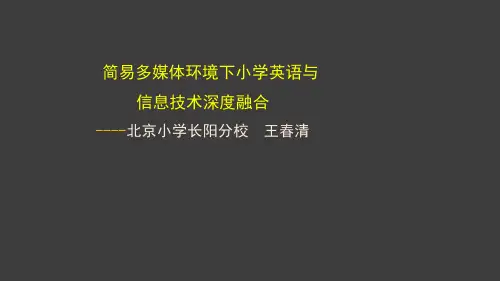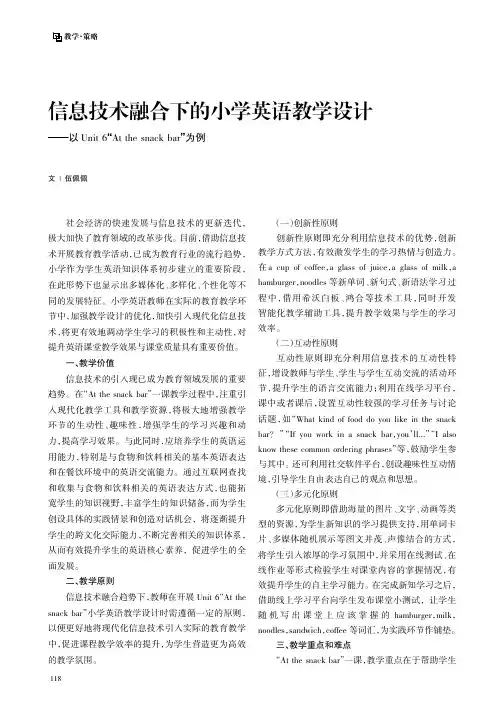【新】小学英语信息化教学设计ppt
- 格式:pptx
- 大小:79.44 MB
- 文档页数:28





小学英语信息化教学设计信息化教学是指通过信息技术手段,将传统教学与现代技术相结合,使教学更加高效、生动、有趣。
在当今信息社会的背景下,信息化教学已经成为教育领域的重要发展方向之一。
对于小学英语教学而言,也可以充分利用信息化教学手段,提高教学效果和学习兴趣。
本文将探讨小学英语信息化教学的设计及其实施策略。
一、利用多媒体教学资源信息化教学的一大特点就是使用多媒体教学资源,包括音频、视频、动画等。
在小学英语教学中,教师可以利用这些资源设计一些生动有趣的教学活动,并且引导学生积极参与其中。
例如,教师可以播放英语歌曲、动画片等,让学生通过听歌、唱歌、跟读等方式来学习英语。
同时,教师还可以选择一些英语相关的绘本,通过展示图片、讲故事等方式让学生更好地理解和掌握英语知识。
二、开展虚拟实验教学信息化教学还可以借助虚拟实验平台,让学生通过模拟实验的方式来学习英语知识。
例如,在学习英语单词拼写方面,教师可以设计一个虚拟实验平台,让学生通过输入拼写,并且通过视觉效果进行即时反馈。
这样,学生能够不断练习并且从错误中学习,提升英语单词拼写能力。
三、利用社交媒体进行课外拓展学习在小学英语信息化教学中,教师可以引导学生利用社交媒体进行课外拓展学习。
例如,学生可以加入英语学习群组或关注一些英语学习的公众号,在社交媒体上与其他学生交流以及参与各种英语学习活动。
这样做不仅可以扩大学生的英语学习范围,还能够增强学生的学习动力和交流能力。
四、开展网络辅助教学和作业信息化教学还可以借助网络辅助教学平台和作业系统,提供更加个性化和有效的教学服务。
在小学英语教学中,教师可以利用网络辅助教学平台,为学生提供一些在线学习资源和教学材料。
同时,教师还可以利用作业系统,布置一些在线作业并及时批改。
这样,学生可以在家进行灵活学习,教师也可以更好地跟踪学生的学习情况。
五、评估学生学习效果信息化教学还可以通过一些在线评估系统,对学生的学习效果进行评估。
通过这些系统,教师可以快速了解学生掌握的程度,并及时调整教学策略和教学内容。




教学·策略信息技术融合下的小学英语教学设计———以Unit6“At the snack bar”为例文|伍佩佩社会经济的快速发展与信息技术的更新迭代,极大加快了教育领域的改革步伐。
目前,借助信息技术开展教育教学活动,已成为教育行业的流行趋势,小学作为学生英语知识体系初步建立的重要阶段,在此形势下也显示出多媒体化、多样化、个性化等不同的发展特征。
小学英语教师在实际的教育教学环节中,加强教学设计的优化,加快引入现代化信息技术,将更有效地调动学生学习的积极性和主动性,对提升英语课堂教学效果与课堂质量具有重要价值。
一、教学价值信息技术的引入现已成为教育领域发展的重要趋势。
在“At the snack bar”一课教学过程中,注重引入现代化教学工具和教学资源,将极大地增强教学环节的生动性、趣味性,增强学生的学习兴趣和动力,提高学习效果。
与此同时,应培养学生的英语运用能力,特别是与食物和饮料相关的基本英语表达和在餐饮环境中的英语交流能力。
通过互联网查找和收集与食物和饮料相关的英语表达方式,也能拓宽学生的知识视野,丰富学生的知识储备,而为学生创设具体的实践情景和创造对话机会,将逐渐提升学生的跨文化交际能力,不断完善相关的知识体系,从而有效提升学生的英语核心素养,促进学生的全面发展。
二、教学原则信息技术融合趋势下,教师在开展Unit6“At the snack bar”小学英语教学设计时需遵循一定的原则,以便更好地将现代化信息技术引入实际的教育教学中,促进课程教学效率的提升,为学生营造更为高效的教学氛围。
(一)创新性原则创新性原则即充分利用信息技术的优势,创新教学方式方法,有效激发学生的学习热情与创造力。
在a cup of coffee,a glass of juice,a glass of milk,a hamburger,noodles等新单词、新句式、新语法学习过程中,借用希沃白板、鸿合等技术工具,同时开发智能化教学辅助工具,提升教学效果与学生的学习效率。


英语信息化教学设计XXX: English n Technology Teaching DesignCase Summary:XXX: I'm Watching TVSubject: EnglishTextbook: Unit 5 of Grade 7 English in People'XXXXXX: 4Designer: NameClass: Class 1Department: Foreign Language CollegeStudent ID: xxxxxxxx0110Major: English (n)Date: November 16.2012XXX:1.n of Learning Objectives (Knowledge and Skills。
Process and Methods。
Attitude and Values):Knowledge and Skills:1) Knowledge objectives: What is someone doing。
He is doing something.2) Ability objectives: XXX describe correctly what a group of people is doing.3) Attitude and values: Through this lesson。
students will learn to use their leisure time XXX。
promote a healthy growth。
establish correct views on life。
the world。
and values。
enhance social responsibility。
XXX.2.Learning Content and Learning Task n (n of learning content。
(全集)小学信息技术课程模块教学方案英文版Title: Comprehensive Elementary Information Technology Curriculum Module Teaching PlanIntroduction:The Comprehensive Elementary Information Technology Curriculum Module Teaching Plan aims to provide a structured and effective approach to teaching information technology in primary schools. This document outlines the objectives, content, teaching methods, assessment strategies, and resources required for successful implementation of the curriculum.Objectives:The primary objectives of the curriculum module are to introduce students to essential information technology concepts, develop their digital literacy skills, and prepare them for future technology-driven challenges. By the end of the module, students should be able to navigate basic software applications, understand internet safety, anddemonstrate proficiency in using digital tools for learning and communication.Content:The curriculum module is divided into several key topics, including computer fundamentals, word processing, spreadsheet applications, internet browsing, and multimedia presentations. Each topic is designed to build upon the previous one, creating a cohesive learning experience for students. The content is presented in a clear and engaging manner to cater to the diverse learning styles of primary school students.Teaching Methods:The teaching methods employed in the curriculum module include hands-on activities, group projects, interactive software tutorials, and multimedia presentations. These methods are chosen to actively engage students in the learning process and promote collaboration and critical thinking skills. Teachers are encouraged to adapt their teaching methods to suit the needs and preferences of their students.Assessment Strategies:Assessment in the curriculum module is designed to measure students' understanding of the content and their ability to apply it in practical scenarios. Formative assessments, such as quizzes, projects, and presentations, are used to provide ongoing feedback to students and inform instructional decisions. Summative assessments, such as exams and performance tasks, are used to evaluate students' overall proficiency in information technology.Resources:The curriculum module recommends the use of various resources, including textbooks, online tutorials, educational software, and internet resources. Teachers are encouraged to explore additional resources that align with the learning objectives of the module and cater to the specific needs of their students. The availability of resources should be taken into consideration when planning and implementing the curriculum.Conclusion:The Comprehensive Elementary Information Technology Curriculum Module Teaching Plan provides a comprehensive framework for teaching information technology in primary schools. Byfollowing this plan, teachers can effectively impart essential digital skills to students and prepare them for success in a technology-driven world.。